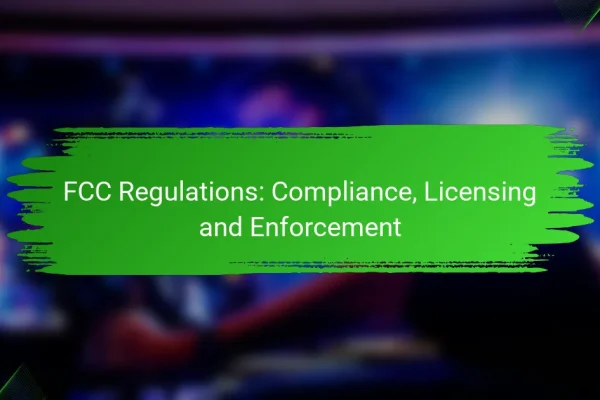What are the key regulations for broadcasting in Australia?
The key regulations for broadcasting in Australia include guidelines set by the Australian Broadcasting Corporation (ABC), commercial broadcasting codes of practice, and the framework established by the Australian Communications and Media Authority (ACMA). These regulations ensure that content meets community standards, promotes diversity, and protects audiences from harmful material.
Australian Broadcasting Corporation (ABC) guidelines
The ABC guidelines govern the operations of the national broadcaster, focusing on impartiality, accuracy, and fairness in content. They require the ABC to provide a diverse range of programs that reflect Australian culture and values, catering to various audiences across the country.
Compliance with these guidelines is essential for maintaining public trust and ensuring that the ABC fulfills its charter obligations. Regular reviews and updates to the guidelines help adapt to changing societal expectations and technological advancements.
Commercial Broadcasting Codes of Practice
Commercial broadcasters in Australia adhere to specific codes of practice that outline standards for content, advertising, and audience engagement. These codes cover areas such as accuracy in news reporting, the portrayal of violence, and the treatment of children in programs.
Broadcasters must regularly review their compliance with these codes and report any breaches to the ACMA. Failure to adhere can result in penalties, including fines or loss of broadcasting licenses, emphasizing the importance of strict adherence to these regulations.
ACMA regulatory framework
The ACMA is responsible for regulating broadcasting, telecommunications, and online content in Australia. Its framework includes licensing broadcasters, monitoring compliance with regulations, and handling complaints from the public regarding content issues.
Broadcasters must ensure they operate within the legal parameters set by the ACMA, which includes adhering to content standards and maintaining transparency in their operations. Regular audits and assessments by the ACMA help ensure that broadcasters meet these obligations effectively.
How to ensure compliance with broadcasting regulations?
Ensuring compliance with broadcasting regulations involves a systematic approach that includes regular audits, staff training, and legal consultations. These steps help organizations meet legal requirements and maintain operational integrity.
Regular audits and assessments
Conducting regular audits and assessments is crucial for identifying compliance gaps in broadcasting operations. These evaluations should be scheduled at least annually and can include reviewing programming content, advertising practices, and technical standards.
Utilize checklists to streamline the audit process, focusing on key areas such as licensing, content restrictions, and accessibility requirements. This proactive approach can help mitigate risks and avoid potential fines.
Staff training programs
Implementing comprehensive staff training programs is essential for fostering a culture of compliance within broadcasting organizations. Training should cover relevant regulations, ethical standards, and best practices to ensure all employees understand their responsibilities.
Consider offering workshops or online courses that are updated regularly to reflect changes in regulations. Engaging staff through interactive sessions can enhance retention and application of compliance knowledge.
Consultation with legal experts
Consulting with legal experts is a vital step in navigating the complexities of broadcasting regulations. Legal professionals can provide tailored advice on compliance issues, helping organizations interpret laws and avoid missteps.
Establish a relationship with a legal advisor who specializes in broadcasting to ensure timely guidance on emerging regulations and industry trends. Regular consultations can help organizations stay ahead of compliance challenges and adapt to changes effectively.
What are the consequences of non-compliance?
Non-compliance in broadcasting can lead to severe repercussions that impact both the financial and operational aspects of a broadcasting entity. Consequences may include fines, loss of licenses, and damage to reputation, which can hinder future business opportunities.
Fines and penalties
Fines for non-compliance can vary widely based on the severity of the violation and the regulatory body involved. In the United States, for instance, fines can range from thousands to millions of dollars depending on the infraction. Regular audits and compliance checks can help mitigate the risk of incurring these penalties.
Broadcasting companies should maintain clear records of compliance efforts to defend against potential fines. Establishing a compliance budget can also be beneficial, ensuring that funds are allocated for necessary training and legal advice.
License revocation
License revocation is one of the most severe consequences of non-compliance, effectively halting a broadcaster’s operations. Regulatory bodies may revoke licenses for repeated violations or serious breaches of broadcasting standards. In many jurisdictions, the process for revocation includes a hearing where the broadcaster can present their case.
To avoid license issues, broadcasters should regularly review their compliance status and engage with legal experts to understand the specific regulations that apply to their operations. Proactive measures, such as implementing compliance training programs, can help prevent license-related problems.
Reputational damage
Reputational damage from non-compliance can have long-lasting effects on a broadcasting entity’s brand and audience trust. Negative publicity can arise from fines or license revocations, leading to decreased viewership and advertising revenue. Rebuilding a tarnished reputation often requires significant time and resources.
To safeguard against reputational harm, broadcasters should prioritize transparency and accountability in their operations. Engaging with the community and maintaining open lines of communication can help mitigate the impact of any compliance issues that arise.
What tools can assist with compliance monitoring?
Several tools can effectively assist with compliance monitoring in broadcasting, ensuring adherence to regulatory standards. These tools range from software solutions to services that provide real-time monitoring and checklists to streamline compliance efforts.
Compliance management software
Compliance management software helps organizations track and manage their compliance obligations efficiently. These platforms often include features like document management, audit trails, and reporting tools to facilitate adherence to regulations.
When selecting compliance management software, consider factors such as user-friendliness, integration capabilities with existing systems, and support for specific broadcasting regulations. Popular options include platforms like ComplyAdvantage and LogicManager, which cater to various compliance needs.
Broadcast monitoring services
Broadcast monitoring services provide real-time tracking of content aired on television and radio, ensuring compliance with regulations regarding content, advertising, and licensing. These services can alert broadcasters to potential violations, allowing for timely corrective actions.
Common features of these services include content archiving, automated alerts for non-compliance, and detailed reporting. Examples include services like Nielsen and Media Monitors, which offer comprehensive monitoring tailored to local regulations.
Legal compliance checklists
Legal compliance checklists serve as practical tools for ensuring that all necessary regulatory requirements are met. These checklists typically outline key obligations related to broadcasting, such as licensing, content standards, and advertising regulations.
Creating a checklist tailored to your specific broadcasting context can help streamline compliance efforts. Include items such as verifying licenses, reviewing content for compliance with decency standards, and ensuring proper disclosures in advertisements. Regularly updating the checklist is crucial to reflect any changes in regulations.
What are the emerging trends in broadcasting regulations?
Emerging trends in broadcasting regulations focus on adapting to technological advancements and societal changes. Key areas include content diversity, digital streaming platform regulations, and data privacy concerns.
Increased focus on content diversity
Regulators are emphasizing the importance of content diversity to ensure that various cultural perspectives are represented in broadcasting. This trend aims to promote inclusivity and prevent monopolistic control over media narratives.
Broadcasters may be required to include a wider range of voices, particularly from underrepresented communities. This could involve setting quotas for diverse programming or incentivizing content that reflects a variety of cultural backgrounds.
Regulations on digital streaming platforms
As digital streaming platforms gain popularity, regulators are implementing new rules to ensure fair competition and consumer protection. These regulations often focus on transparency in pricing, content accessibility, and user data management.
For instance, some countries are considering laws that require streaming services to invest a certain percentage of their revenue back into local content production. This aims to support local creators and maintain a competitive landscape against traditional broadcasters.
Data privacy and broadcasting
Data privacy is becoming a critical concern in broadcasting, especially with the rise of personalized content delivery. Regulations are being introduced to protect user data and ensure that broadcasters handle personal information responsibly.
Broadcasters must comply with regulations such as the General Data Protection Regulation (GDPR) in Europe, which mandates strict guidelines on data collection and user consent. Failure to adhere to these regulations can result in significant fines and damage to reputation.
How to prepare for future regulatory changes?
To prepare for future regulatory changes in broadcasting, organizations should proactively engage with industry trends and regulatory bodies. This involves staying informed about potential shifts in regulations and adapting compliance strategies accordingly.
Engage with industry associations
Joining industry associations can provide valuable insights into upcoming regulatory changes. These organizations often conduct research, publish reports, and host events that focus on compliance issues relevant to broadcasting.
Participating in these associations also allows for networking opportunities with peers, which can lead to shared knowledge and best practices for navigating regulatory landscapes.
Stay updated with ACMA announcements
The Australian Communications and Media Authority (ACMA) regularly issues updates and guidelines that affect broadcasting regulations. Subscribing to ACMA newsletters or following their official website can help organizations stay informed about new policies and compliance requirements.
Additionally, attending ACMA-hosted workshops or forums can provide deeper insights into regulatory expectations and allow for direct interaction with regulatory officials.
Implement adaptive compliance strategies
Adaptive compliance strategies involve creating flexible frameworks that can quickly adjust to regulatory changes. This may include regular reviews of compliance processes and the incorporation of feedback mechanisms to identify areas for improvement.
Organizations should also consider investing in compliance management software that can automate tracking of regulatory changes and facilitate timely updates to internal policies and procedures.









